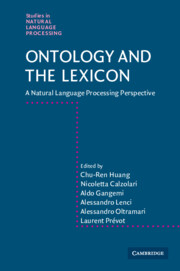Book contents
- Frontmatter
- Contents
- Contributors
- Preface
- Part I Fundamental aspects
- Part II Discovery and representation of conceptual systems
- Part III Interfacing ontologies and lexical resources
- 10 Interfacing ontologies and lexical resources
- 11 Sinica BOW (Bilingual Ontological WordNet): integration of bilingual WordNet and SUMO
- 12 Ontology-based semantic lexicons: mapping between terms and object descriptions
- 13 Merging global and specialized linguistic ontologies
- Part IV Learning and using ontological knowledge
- References
- Index
11 - Sinica BOW (Bilingual Ontological WordNet): integration of bilingual WordNet and SUMO
from Part III - Interfacing ontologies and lexical resources
Published online by Cambridge University Press: 06 July 2010
- Frontmatter
- Contents
- Contributors
- Preface
- Part I Fundamental aspects
- Part II Discovery and representation of conceptual systems
- Part III Interfacing ontologies and lexical resources
- 10 Interfacing ontologies and lexical resources
- 11 Sinica BOW (Bilingual Ontological WordNet): integration of bilingual WordNet and SUMO
- 12 Ontology-based semantic lexicons: mapping between terms and object descriptions
- 13 Merging global and specialized linguistic ontologies
- Part IV Learning and using ontological knowledge
- References
- Index
Summary
Background and motivation
The ontolex interface is anchored on two essential elements of human knowledge: conceptual structure and lexical access. A well-structured ontolex interface facilitates bilingual representation of both the conceptual structure and the lexical information which will be crucial in overcoming linguistic barriers. In this chapter we propose a robust and versatile approach for constructing the ontolex interface infrastructure: Bilingual Ontological WordNet (BOW). The Academia Sinica Bilingual Ontological WordNet (Sinica BOW) was constructed in 2003 using this approach. We argue that this novel combination of ontology and WordNet will (1) give each linguistic form a precise location in the taxonomy, (2) clarify the relation between the conceptual classification and its linguistic instantiation, and (3) facilitate a genuine crosslingual access of knowledge.
In terms of the ongoing research regarding ontologies and lexical resources, the issue of multilingual application remains an area of opportunity and challenge. On the one hand, an ontology provides a platform whereby knowledge can be represented uniformly across different languages. On the other hand, the complex mapping between linguistic forms and meanings needs to be explicitly represented in a lexical knowledge-base. The mappings are compounded when crosslingual correspondences are considered. For the successful application of ontology and lexical resources to multilingual language processing, it will be essential that these two components are integrated. In this chapter, we propose a framework for integrating bilingual WordNet with an upper ontology.
- Type
- Chapter
- Information
- Ontology and the LexiconA Natural Language Processing Perspective, pp. 201 - 211Publisher: Cambridge University PressPrint publication year: 2010
- 6
- Cited by



